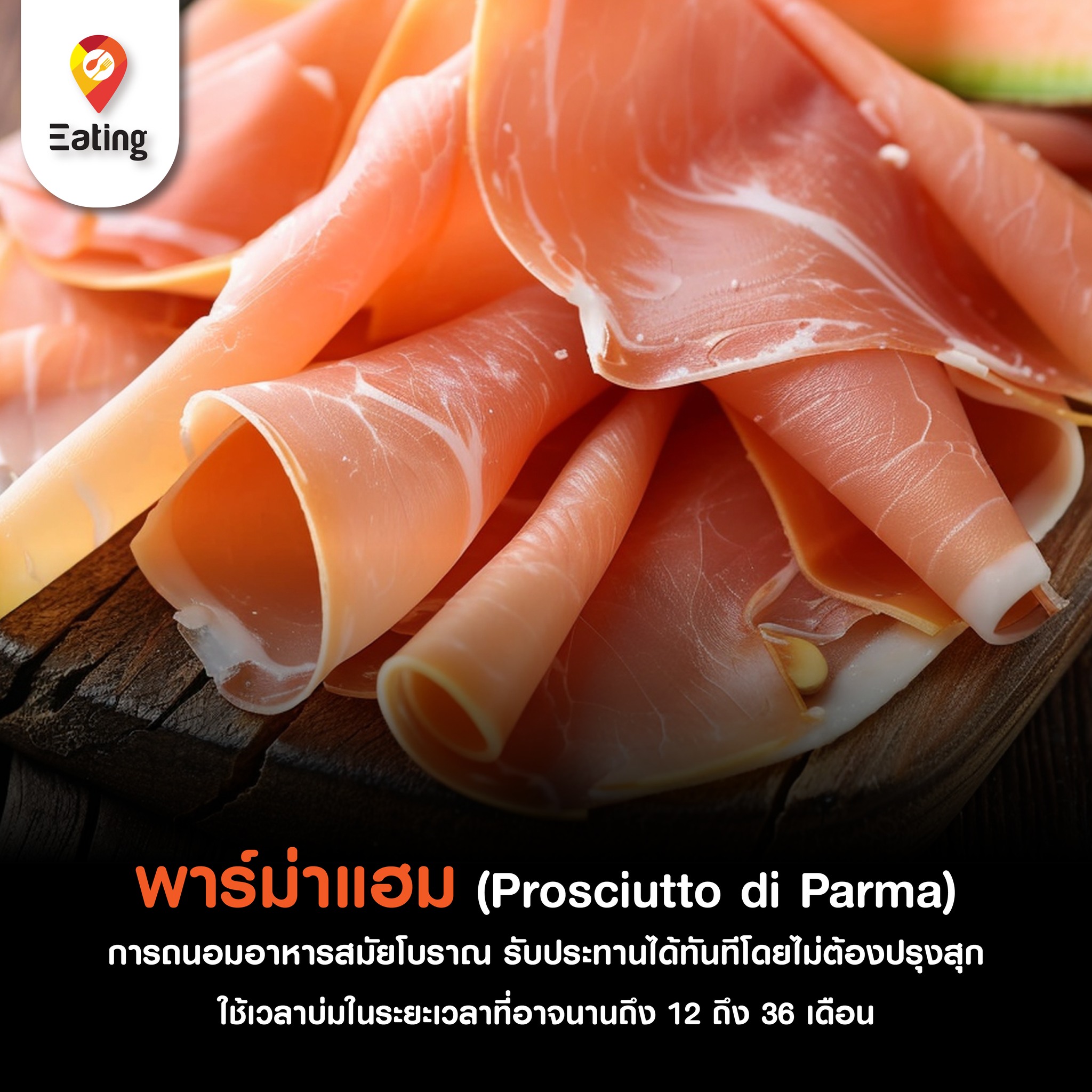Insider
New Experience

พาร์ม่าแฮม(Prosciutto di Parma)
การถนอมอาหารสมัยโบราณ รับประทานได้ทันทีโดยที่ไม่ต้องปรุงสุก
พาร์ม่าแฮม (Prosciutto di Parma) เป็นหนึ่งในศิลปะการผลิตอาหารที่มีประวัติยาวนานและเต็มไปด้วยตำนานเล่าขานในดินแดนอิตาลี ตั้งแต่สมัยโบราณที่ชาวนาในหุบเขาและทุ่งนาในแคว้นพาร์มาได้เรียนรู้การเก็บรักษาเนื้อหมูด้วยวิธีการเค็มและบ่มแห้ง เพื่อให้สามารถเก็บไว้ได้นานในสมัยที่ไม่มีเทคโนโลยีการทำความเย็น ในช่วงเวลานั้นเองแนวคิดในการ “ถนอมอาหาร” เกิดขึ้นอย่างค่อยเป็นค่อยไปและพัฒนาไปสู่รูปแบบที่เรารู้จักในทุกวันนี้
.
ตำนานเล่าว่าในสมัยโรมันมีนักปรุงอาหารที่มีความเชี่ยวชาญในการคัดเลือกเนื้อหมูที่ดีที่สุดจากฟาร์มท้องถิ่น เขาได้ทดลองผสมผสานเกลือจากทะเลที่มีคุณสมบัติพิเศษกับวิธีการหมักและบ่มที่ถูกถ่ายทอดจากรุ่นสู่รุ่น กระบวนการนี้ไม่เพียงแต่ช่วยยืดอายุการเก็บรักษาเนื้อหมูเท่านั้น แต่ยังเปลี่ยนแปลงรสชาติให้มีความละมุน หอมหอม และมีเอกลักษณ์เฉพาะตัว ที่เรียกว่าพาร์ม่าแฮม เมื่อเวลาผ่านไป ชื่อเสียงของพาร์ม่าแฮมก็เริ่มแพร่หลายไปยังภูมิภาคอื่น ๆ ในอิตาลีและต่อมาได้กลายเป็นหนึ่งในสินค้าอาหารที่ได้รับการยกย่องในระดับนานาชาติ
.
ความพิถีพิถันในกระบวนการผลิตพาร์ม่าแฮมนั้นเป็นสิ่งที่สร้างความแตกต่างอย่างชัดเจน ก่อนเริ่มกระบวนการบ่ม แฮมจะถูกเลือกสรรจากหมูที่มีคุณภาพสูงเท่านั้น หลังจากนั้นจะผ่านการเคลือบด้วยเกลือธรรมชาติที่มีคุณภาพ เพื่อดึงความชุ่มชื้นออกจากเนื้อและป้องกันการเจริญเติบโตของเชื้อโรค หลังจากการเคลือบเกลือแล้ว เนื้อแฮมจะถูกนำไปแขวนในห้องบ่มที่มีการควบคุมสภาพอากาศอย่างพิถีพิถัน ซึ่งมักจะเป็นสถานที่ที่มีอากาศบริสุทธิ์และมีความชื้นในระดับที่เหมาะสม เพื่อให้กระบวนการบ่มเกิดขึ้นอย่างช้าๆ ภายในระยะเวลาที่อาจนานถึง 12 ถึง 36 เดือน ระยะเวลาที่ยาวนานนี้ช่วยให้เนื้อแฮมมีรสชาติที่กลมกล่อมและเนื้อนุ่มละลายในปาก
.
ในตำนานของพาร์ม่าแฮม ยังมีเรื่องเล่าว่าชาวเมืองพาร์มาเคยให้ความศรัทธาในพลังแห่งธรรมชาติที่มีอิทธิพลต่อรสชาติของอาหาร ซึ่งเชื่อว่าการบ่มในสภาพแวดล้อมที่มีอากาศและดินที่อุดมสมบูรณ์ของแคว้นพาร์มานั้นมีส่วนช่วยเสริมสร้างรสชาติอันพิเศษให้กับแฮมชนิดนี้ นอกจากนี้ยังมีการกล่าวถึงความสัมพันธ์ระหว่างความศรัทธาในศิลปะการปรุงอาหารและวัฒนธรรมการรับประทานอาหารของชาวอิตาเลียน ที่มองว่าอาหารไม่ได้เป็นเพียงแค่สิ่งที่มาทำให้หิว แต่ยังเป็นงานศิลปะและวัฒนธรรมที่ถ่ายทอดความรักและความภูมิใจในท้องถิ่น
.
เมื่อพาร์ม่าแฮมเข้าสู่ยุคสมัยใหม่ เทคนิคการผลิตก็ยังคงรักษาแบบดั้งเดิมไว้ แม้ว่าจะมีการปรับปรุงเทคโนโลยีในบางขั้นตอนเพื่อให้ได้มาตรฐานความปลอดภัยของอาหาร แต่หลักการและความพิถีพิถันในทุกขั้นตอนยังคงเป็นหัวใจหลักในการผลิตแฮมชนิดนี้ ผลิตภัณฑ์ที่ได้ไม่เพียงแต่เป็นอาหารที่รับประทานได้ทันทีโดยไม่ต้องปรุงสุก แต่ยังเป็นตัวแทนของประวัติศาสตร์และวัฒนธรรมของชาวอิตาเลียนที่รักในรสชาติแท้จริงของวัตถุดิบธรรมชาติ
.
พาร์ม่าแฮมจึงไม่ใช่เพียงแค่อาหารเท่านั้น แต่เป็นการผสมผสานระหว่างศิลปะ วัฒนธรรม และความรู้ที่สืบทอดกันมาหลายชั่วอายุคน เป็นสัญลักษณ์ของความพิถีพิถันและความมุ่งมั่นที่จะถนอมรสชาติที่ดีที่สุดจากธรรมชาติ เมื่อคุณได้ลิ้มรสพาร์ม่าแฮม คุณไม่ได้เพียงแค่รับประทานอาหาร แต่ยังได้สัมผัสกับเรื่องราวและประวัติศาสตร์ที่เต็มไปด้วยความรักและความภาคภูมิใจในศิลปะการทำอาหารของแคว้นพาร์มานั่นเอง
Parma Ham, or Prosciutto di Parma, is one of the finest culinary arts with a long-standing history and legendary tales in Italy. Dating back to ancient times, farmers in the valleys and fields of the Parma region mastered the art of preserving pork through salting and air-drying. This method allowed them to store meat for long periods before refrigeration technology existed. Over time, the concept of "food preservation" gradually evolved into the form we recognize today.
A Legend from Ancient Rome
According to legend, during the Roman era, skilled cooks meticulously selected the finest pork from local farms. They experimented with unique sea salt combined with traditional curing and aging techniques passed down through generations. This process not only extended the shelf life of the pork but also enhanced its flavor, creating the delicate, aromatic, and distinct taste known as Parma Ham. As time passed, its reputation spread beyond the Parma region, eventually becoming one of the most esteemed food products worldwide.
The Art of Crafting Parma Ham
The meticulous production process of Parma Ham is what sets it apart. Only premium-quality pork is selected before undergoing the salting process, where it is coated with high-quality natural salt. This step helps draw out moisture and prevent bacterial growth. After salting, the ham is hung in carefully controlled aging rooms, often in areas with fresh air and ideal humidity. The slow curing process can take anywhere from 12 to 36 months, allowing the flavors to develop into a rich, melt-in-your-mouth texture.
Nature’s Influence on Its Unique Flavor
Legends also speak of the people of Parma believing in the power of nature, influencing the flavor of their food. They attributed the exceptional taste of Parma Ham to the region’s pure air, fertile soil, and ideal climate. Moreover, Italian culinary traditions emphasize that food is not just for nourishment—it is an art form and a cultural heritage that expresses love and local pride.
Parma Ham in the Modern Era
Even in modern times, the traditional techniques of producing Parma Ham remain largely unchanged. While some technological advancements have been introduced to meet food safety standards, the fundamental principles and attention to detail in every step remain at the heart of its production. The final product is not only ready to eat without cooking but also serves as a symbol of Italian history, culture, and the appreciation of natural flavors.
More Than Just Food—A Legacy
Parma Ham is more than just a delicacy; it is a harmonious blend of art, tradition, and generational knowledge. It stands as a testament to dedication and the passion for preserving the finest natural flavors. When you savor Parma Ham, you are not merely enjoying food—you are experiencing a story rich in love, heritage, and the culinary artistry of the Parma region.